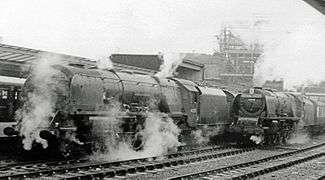Royal Scot (train)
The Royal Scot was a British named express passenger train that ran between London Euston and Glasgow Central, the length of the West Coast Main Line (WCML), with previously a portion also going to Edinburgh.
.jpg) Royal Scot ca. 1928 hauled by "Royal Scot" Locomotive, No.6137 "Vesta" | |
| Overview | |
|---|---|
| Service type | Passenger train |
| First service | 1927 |
| Last service | 2003 |
| Current operator(s) | Virgin Trains |
| Former operator(s) | LMS, BR |
| Route | |
| Start | London Euston |
| End | Glasgow Central |
| Service frequency | Daily |
| Line(s) used | West Coast Main Line |
The service in steam days

The timetabled service which eventually was known as the Royal Scot first ran in 1862. For many years it departed from both ends at 10:00 (mirroring the Flying Scotsman on the East Coast Main Line). From 1874, the train was hauled by LNWR Improved Precedent Class 2-4-0 locomotives. When 4-4-0 locos became available from 1897, the train was generally hauled by one of the fastest engines available. Early on this would normally be a LNWR Precursor Class 4-4-0, then from 1913 the LNWR Claughton Class 4-6-0, in each case with a change to Caledonian Railway locomotives at Carlisle Citadel and over Beattock Summit to Glasgow.
Named as Royal Scot
From 1927 the London Midland and Scottish Railway titled the train The Royal Scot,[1] a title which applied to the journey in both directions. The modern and more powerful LMS Royal Scot Class 7P 4-6-0 locos took over at this time, with an English-based engine being replaced at Carlisle by a Glasgow (Polmadie)-based loco of the same class. The train gradually became heavier, including heavy dining cars, and from 1933, 4-6-2 pacifics of the 8P LMS Princess Royal Class took over, followed by LMS Coronation Class locos during 1937. These engines sometimes worked the train "non-stop" throughout, but with a brief stop at Carlisle for a change of crew. Post-war, the 4-6-2 loco and crew normally changed over at Carlisle.
In 1960 the down Royal Scot had its departure time from Euston changed to 09:05. The down train was speeded up by 40 minutes and the up train by 15 minutes, for a new journey time in both directions of 7 hours 15 minutes, identical with the other two daytime named trains of the era between London and Glasgow, The Caledonian and the Mid-Day Scot. All three trains at this period were restricted to eight coaches to save weight, and the number of passengers carried was limited to the seating capacity of the train, standing passengers not being permitted. All three trains ran non-stop between London and Carlisle.[2]
The train in the diesel- and electric-hauled period
Diesel locomotives started to take over haulage of the train from the early 1960s. AC electric locomotives took over in 1966 following the electrification of the WCML south of Crewe, with diesel locomotives continuing to pull the train north of Crewe.
By 1972 the London departure time of the Royal Scot had become 10:05, that from Glasgow 09:25, with a total journey time of 6 hours 35 minutes. It ran Monday to Saturday, and called only at Crewe and Carlisle.[3]
Electrification to Glasgow took place in 1973-4, ending the locomotive change at Crewe and bringing the replacement of the early electric locomotives with the new British Rail Class 87s, titled Royal Scots by BR although better known as Electric Scots, in order to avoid clashing with the earlier steam locomotive class of that name.
The first stop out of Euston became Preston, for a crew change, and calls were now also made at Oxenholme and Carlisle. Traction became more mixed following the arrival of British Rail Class 90s in 1988.
The service lost its name in 2003 and there is now no equivalent special train. Instead, London-Glasgow now has an hourly (peak) or two-hourly (off-peak) service of British Rail Class 390 Pendolino units operated by Virgin Trains with a standard overall journey time of 4 hours 31 minutes, running non-stop between London and Warrington Bank Quay.
See also
External links
References
- "Summer Services. More and Faster Trains Next Week". Derbyshire Advertiser and Journal. England. 8 July 1927. Retrieved 13 November 2017 – via British Newspaper Archive.
- "The winter timetables of British Railways". Trains Illustrated. Hampton Court: Ian Allan. December 1959. p. 584.
- Passenger Timetable 1 May 1972 to 6 May 1973. London: British Railways, London Midland Region. pp. 79, 100.